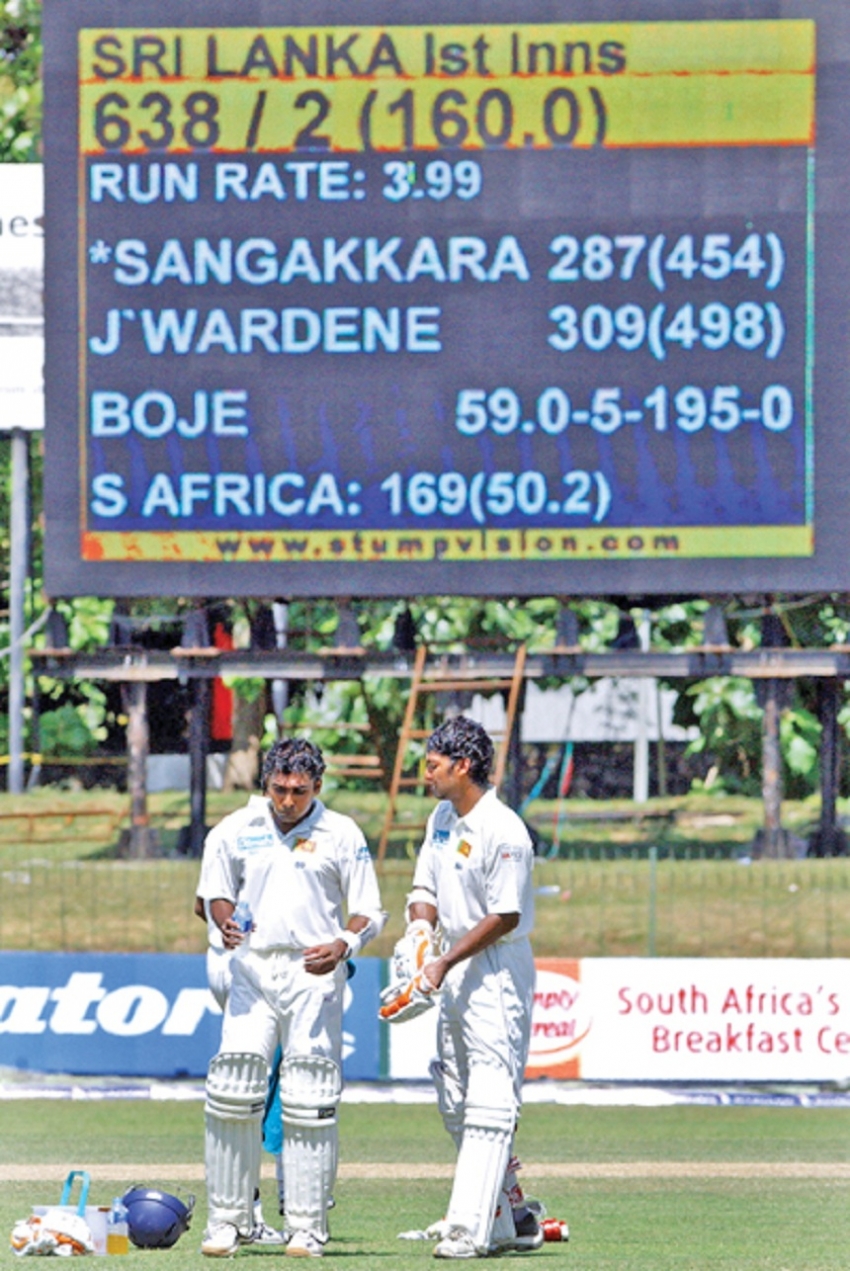Mahela Jayawardene and Kumar Sangakkara made 19 career centuries between them at the SSC. They are pictured here during their world record partnership of 624 against South Africa.
When David Warner made his unbeaten 335 in Adelaide, a fair few people felt inclined to present some caveats. The pitch was flat, the bowlers were no good, the ball didn’t swing, Mercury was in retrograde. Those opinions would hardly have been muffled when the Pakistan tail-ender Yasir Shah made his first Test ton in reply, having never previously passed 50.
In a deeply surprising result, though, it turns out that all triple centuries tend to get made in conditions favourable to batting. This is a bit like the 100m sprint record not tending to be set uphill. Almost by definition, if one batsman can make 300 runs on his own, the bowling and the fielding can’t have been all that good.
Brian Lara had the quintessential Big Score Energy. He held the world record for a decade with 375, lost it to Matthew Hayden’s 380, then within six months had taken it back with 400. We stan a petty genius.
Lara’s scores came on the Antigua pitch routinely described as a featherbed, where in 22 Tests there have been 23 team scores over 400, two scores over 700 and the world-record run chase of 418. Lara’s scores came against England, notoriously poor tourists in the West Indies (in many senses of that phrase).
Hayden’s day out came in Perth against Zimbabwe – and not even the good Zimbabwe, but the Blignaut-Ervine-Price configuration mixed in with the few remaining chunks of Heath Streak’s knee cartilage. Hayden was caught on the fence off part-time tweaker Trevor Gripper, the calibre of player who averaged 84 with the ball and 21 with the bat.
Mahela Jayawardene fell short of Lara with 374 against South Africa. This was at the Sinhalese Sports Ground in Colombo, where the ghosts of bowlers past, present and future twist and groan beneath the centre wicket in a state of eternal unrest. Chilling at the other end in that innings was Kumar Sangakkara making 287 and kicking himself for missing the first double triple. Those two batsmen made 19 career centuries between them at the venue.
None of these matches had anything going for them besides the records they contained. Out of 31 matches with triples, there have been 18 draws and 11 defeats by an innings. Only two wins have had conventional margins. Only a couple of the draws have been close.
Hanif Mohammad created one in 1958. He batted for half of a six-day Test in Barbados after a new and fragile Pakistan team was bowled out for 106 in 42 overs. It was a decent deck, given the West Indies had made nearly 600, but following on to make 337 was beyond anything reasonable. Hanif’s 970 minutes in the second innings remains the longest vigil in Test cricket.
That only made Garfield Sobers mad though, the West Indies all-rounder responding a few weeks later with an unbeaten 365 against Pakistan’s fledgling bowlers. His world record lasted 36 years until Lara.
Two Pakistan centuries plus a run-out 260 from Conrad Hunte give a sense of the batting conditions: West Indies declared at three down with nearly 800 on the board.
Sobers passed Len Hutton’s 364, which had been made in conditions that allowed England to score 903 at the Oval. Australia’s left-arm spinner Chuck Fleetwood-Smith got monstered for nearly 300 himself, and batsmen Stan McCabe, Lindsay Hassett, Sid Barnes and Donald Bradman bowled 91 overs between them.
Sanath Jayasuriya’s 340 in Colombo came in a match of five days, two innings, six centuries, and 14 wickets. Wally Hammond made 336 in 1933 while beating up New Zealand, a team that would wait 23 more years for its first Test win. England still drew the match.
Now Warner rounds out the top 10, and any asterisks applied to his innings could be roundly applied to the others. So the story goes. Virender Sehwag and Chris Gayle made two triples each, using some Asian roads and Lara’s ground at Antigua. Bradman made two at Leeds while being Bradman, both in draws.
Mark Taylor’s came in a 1,468-run draw in Peshawar. Graham Gooch probably wasn’t too worried about Manoj Prabhakar and Ravi Shastri at Lord’s in a match that saw six tons. Michael Clarke’s main foes were a fading Zaheer Khan and a toothless Ishant Sharma.
The first triple, Andy Sandham’s 325, came against a 1930 West Indies side in its infancy.
Sangakkara at his peak met a Bangladesh team that wasn’t. Younis Khan’s triple followed two Sri Lankan doubles on the same Karachi pitch. Bob Simpson’s 311 was followed by Ken Barrington’s 256 in Manchester. Only four South Africans were required in the innings when Hashim Amla went large, with three making hundreds. Bob Cowper’s 307 came on a Melbourne deck where England had just made nearly 500.
New Zealand improved between conceding John Edrich’s triple in 1965 and Inzamam-ul-Haq’s in 2002, but it wasn’t exactly imposing in Lahore facing down Daryl Tuffey, Chris Martin, Chris Harris and Brooke Walker.
Karun Nair was the outlier in a 2016 run-fest series where India kept going huge to swamp England’s merely large. Azhar Ali was on such a mild Dubai deck that West Indies stayed in touch and nearly ended up chasing 346.
So Azhar joined his compatriot Hanif in one of the few close games to include a triple. Lawrence Rowe is there, with his 302 at a fast clip in reply to England’s 395 in Barbados. He got West Indies 200 runs ahead, but England clung on for the draw. Lastly Brendon McCullum: his team bowled out for 192, conceding 438, then the New Zealand captain saving the game from 94-5.
Four vaguely close finishes out of 31, then. Two occasions when the triple was made from a position of serious disadvantage. Otherwise, triple centuries tend to come early in a contest and kill it. They’re big and shiny but unwieldy. They need everything in their favour to occur. Only in that context, the batsman’s skill and endurance can create something, but even with everything going right they remain vanishingly rare. When they do come along, that is what should be appreciated.




















